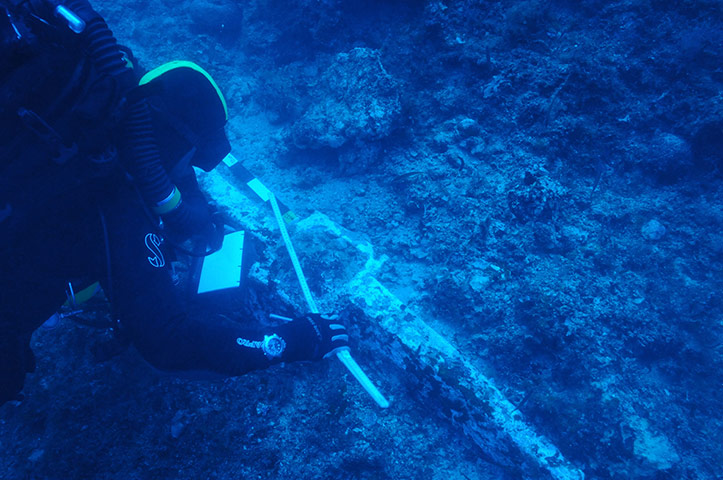Into the deep blue sea
she went, a ship, or maybe two, with similar cargo on a similar
voyage, sunk, lost, forgotten. Over time she was to give up and
slowly disintegrate and vanish. Leaving few of her timbers behind and spilling all that belonged to her
across the rocky sea bed off the Greek Island of Antikythera. And why
wouldn't she give up on us? For she was old. Ancient even. Her
timbers worn and worried by the sea currents since the First Century
BC. She could not hold out forever. Waiting for us to find her and take back her cargo. Yet it was the secrets of her cargo that have captured our
imaginations.
 Her mysterious
clockwork mechanism known as the The Antikythera Mechanism, the peculiar
bronze objects yet to reveal their true identity, the strange rough
sphere's, like rocks tossed across the sea floor, containing
fragments of metal that could indicate that they were once bronze.
Her mysterious
clockwork mechanism known as the The Antikythera Mechanism, the peculiar
bronze objects yet to reveal their true identity, the strange rough
sphere's, like rocks tossed across the sea floor, containing
fragments of metal that could indicate that they were once bronze.
Her grave lays beneath what was, for many centuries, a busy shipping lane and yet the Antikythera wreck is strangely an isolated event. Unlike many shipping lanes that are wretched with reefs and cliffs and that have been used for a long period of time, not many wrecks haunt the sea bed with her.
The wreck was first discovered in the early 1900s (1900-1901) by Sponge Divers, assisted by the Royal Greek Navy, who wasted no time in lifting some of her treasures to the surface.
Then in 1976 Jacques
Cousteau popped his head in whilst filming a documentary called
Diving For Roman Plunder. But the site where Cousteau found his
artefacts is 200 metres from where the newest, perhaps truer, site
has been found by Aggeliki Simossi of Greece's Ephorate of Underwater
Antiquities and Brendan Foley of Woods Hole Oceanographic
Institution.
In October 2012, this
team did some dives in the area and using diver propelled vehicles strapped
with High Resolution Video cameras they explored more ground than
Cousteau or the sponge divers and it was at the base of a steep
underwater cliff, somewhere between 30 metres and 60 metres down,
that they made their discoveries. The evidence of a ship wreck.
Either the same one Jacques Cousteau had found, or, despite an
Amphora making a dna match to amphora Cousteau found, potentially an
entirely different wreck. The matching dna could mean that it is
wreckage from the same ship, or perhaps from the same fleet or the
same trader.
Amoung their
discoveries was a large lead anchor stock which may have indicated
that the ship was sailing when it went down.
 |
Theotokis Theodoulou
examines the ship’s lead anchor stock,
about 1.4 metres long and
weighing close to 200kg.
|
For the first time ever, ALL artefacts will be on display.
If you cannot make it, then the National Archaeological Museum in Greece hosts selected artefacts from the exhibition every month to feature online. Artefacts can be viewed here: Objects of the Month
The Museum states, in relation to the exhibition, that;
“The study of
the cargo will deal with the circulation and
trade in the East Mediterranean
from the point of view of the aesthetic taste of the rising Roman
elite in the end of the Hellenistic Era and the Rome’s democratic
period.”
Sounds incredibly fascinating. You should check it out if you can.
- MM
No comments:
Post a Comment